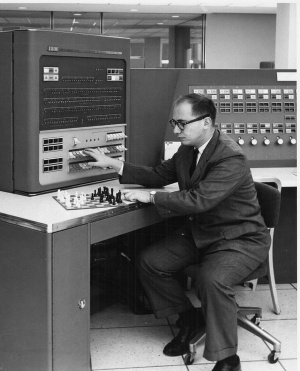IBM 704
IBM 704, the first mass-produced computer, still with vacuum tubes. It used floating point arithmetic hardware and Magnetic core memory, three index registers, 36-bit words. The IBM 704 was able to process about 40,000 instructions per second, and was introduced in 1954. The instruction format was 3-bit prefix, 15-bit decrement, 3-bit tag, and 15-bit address. The prefix field specified the class of instruction, the decrement field often contained an immediate operand, or was used to further define the instruction type. The tag bits specified any combination of three index registers, in which the contents of the registers were subtracted from the address to produce an effective address of an memory operand. The programming languages Fortran and Lisp were first developed for the 704. In 1957 Alex Bernstein et al. wrote the first complete chess program for the IBM 704, The Bernstein Chess Program.
Chess Programs
See also
Selected Publications
- Alex Bernstein, Michael de V. Roberts, Timothy Arbuckle, Martin Belsky (1958). A chess playing program for the IBM 704. Proceedings of the 1958 Western Joint Computer Conference, pdf
- John McCarthy (1960). Recursive Functions of Symbolic Expressions and Their Computation by Machine, Part I, Massachusetts Institute of Technology, pdf
External Links
- IBM 704 from Wikipedia
- IBM Archives: Photo Album: 704 Data Processing System
- The IBM 704 by Frank da Cruz, Columbia University
- From the IBM 704 to the IBM 7094 by John J. G. Savard
- Photos by Andreas Feininger, Getty Images
References
- ↑ IBM programmer Alex Bernstein 1958 Courtesy of IBM Archives from The Computer History Museum
